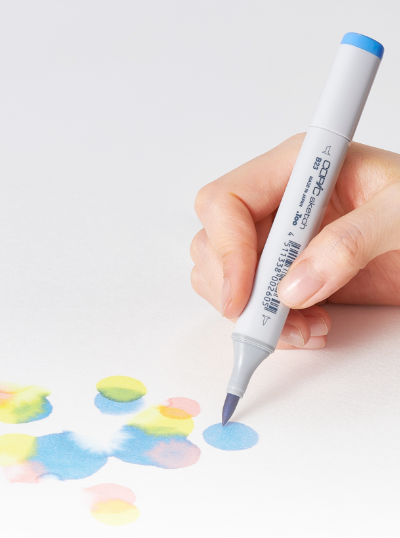Color Schemes 2
15-03-2022
Monochromatic, Triad, and Tetrad
How can I create a good-looking color palette for my drawings?

Earlier this month, we introduced three different color schemes you can easily find by using a color wheel: analogous, complementary and split-complementary. In this blog, we are going to introduce three more ways you can group colors together using monochromatic, triad, and tetrad color schemes! After reading this blog, you’ll have no trouble creating your own color palettes with Copic markers!

First up, we have the monochromatic color scheme. This one is pretty straightforward: pick one color on the wheel and create variations to it by adding white or black. In painting terms, this means that you’re creating tints (adding white) and shades (adding black). In Copic terms, since alcohol markers work differently than paints, this means that for any mid-tone color, there will most likely be lighter values and darker values in the same color group, like in the example graphic above.

However, some colors on the Copic color wheel stand alone, like BG23, for example, since there are no other BG2_ colors. There are, however, 7 different BG0_ markers, so these larger color groups will give you more range when coloring in a monochromatic color scheme!

Next up, we have triads. Triads consist of three equidistant colors on the wheel, such as blue, red, and yellow (the primary colors). Because of how spaced out the colors are, the triad palette is not made for someone looking to be subtle…it’s made to be bold and stand out! If you live in an area that’s cloudy and rainy most of the time, imagine how much your home would stand out if you painted it in blocks of red, yellow, and blue (or violet, green, and orange)!

Another example of a triad color scheme would be fall leaves, as seen above. They come in so many different colors and can create a more subtle violet, orange, and green palette.

Lastly, we have tetrads. This color scheme uses four colors on the color wheel that are actually two sets of complementary colors. For example, blue and orange with red and green. This color scheme can get complicated very easily, but with light and bright variations, they can become more subtle and pleasing to look at.

Take these buildings in Cape Town, South Africa, for example. A tetrad color scheme was used to create a bold candy-colored exterior, however, because the paint colors are tinted (white is added to the original color), the tetrad comes across as less “in-your-face” and is quite pleasing! In the other dessert example, we see red raspberries next to green mint leaves, and dark violet blueberries on top of the lemon-colored dish. This tasty dessert looks even sweeter with this beautiful tetrad color scheme!

That wraps up our second blog on color schemes! We’ve introduced what monochromatic, triad, and tetrad palettes entail, and later in the month, we’ll show how you can apply these three color schemes using Copic markers to your own illustrations! Until then!
Read More Articles
Copic Acrea on Canvas
How to use Acrea on various types of Canvas Hello Copic readers! In our previous blog, we wrapped up our discussion on how to use Acrea o...

The Best Papers for COPIC Acrea
How to Layer with Acrea on Various Types of Paper Hello Copic readers! In our previous blog, we wrapped up our discussion on how to use ...

Copic Acrea with Copic Ink
How can Acrea be used with Copic Ink? Greetings Copic readers! In our previous blog, we discussed how Acrea compares with Copic Multil...

Copic Acrea with Multiliners
How does Acrea compare with Copic Multiliner Pens? Greetings Copic readers! In our previous blog, we discussed how Acrea compares to the ...





